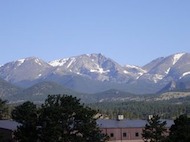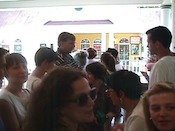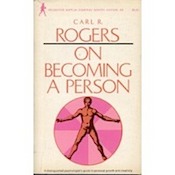In 1975, two science education colleagues (Roger Bybee and Bob Sund) suggested that I attend the Association for Humanistic Psychology (AHP) annual meeting, which was being held at the YMCA of Rockies, in Estes Park Colorado, which was at the Eastern entrance to the Rocky Mountain National Park.I arrived in the Rockies in August, 1975, eager to participate in the conference. Founded by Abraham Maslow, Carl Rogers and Rolo May, AHP offered a hopeful, constructive and creative view of human beings, focusing on qualities such as choice, creativity, collaboration, and as Carl Rogers said, “a new type of self-empowered person who is emerging.”John Richardson, my major professor at The Ohio State University suggested that I read Rogers’ book, On Becoming a Person, and two years later Rogers published his groundbreaking book, Freedom to Learn, which became a textbook in many of the courses I taught, including science methods.I began to read as much as I could about humanistic psychology and education. Much of Rogers’ and other humanistic psychology views on teaching impacted they way that I taught and organized my courses at GSU.
At the conference in the Rocky Mountains I joined AHP, organized a humanistic education conference (Celebration of the Teacher) which featured George Leonard, Jack Canfield, and Bob Samples at Georgia State University. I began teaching graduate courses on humanistic education, and changed my orientation to science teaching to embody the humanistic philosophy.
In 1976, Joe Abruscato and I published our first book with the Goodyear Publishing Company, Loving and Beyond: Science Teaching for the Humanistic Classroom.The book outlined our humanistic, experiential, and inquiry approach to teaching, and was used in many universities in elementary and middle school science methods courses. We described our view of humanistic science with the following phrases:
- Science is a human experience. It involves humans looking out at their world.
- Science usually involves a cooperatives human effort. The scientist, alone, high in a ivory tower, is an inaccurate view of the scientific role.
- The basic processes of science, such as discovering, valuing, and exploring, are applicable to many of the human social problems people face, problems that include social change and the improvement of interpersonal relationships.
- Certain products of science, as transmitted through technology, can be used to alleviate human suffering resulting from poverty, disease, and illiteracy.
- The essence of humanism, as we see it, is that each human being should be encouraged to utilize her or his full human potential, as well intellectual and social potential.
Our next book with Goodyear, published the following year was titled The Whole Cosmos Catalog of Science Activities for People of All Ages.It extended the view of humanistic science education by focusing on creativity and the interdisciplinary nature of science teaching.The Whole Cosmos, 2nd Edition was published in 1992, and is still in print.These books helped us learn how to integrate humanistic philosophy with inquiry-based science teaching.
In 1983 I was a participant in AHP’s first delegation to the Soviet Union to launch the AHP Soviet Exchange Project organized by Fran Macy.[i]As North American psychologists, psychotherapists, and educators, without official invitation, we sought ways to establish ties with prestigious institutes, universities and schools in the states of the former Soviet Union.These early visits set the stage for more organized and official relationships with Soviet colleagues and institutions would begin for me nearly two decades (1983 -2000) of collaboration with Russian teachers, professors and researchers[ii].We established relationships with psychology and education institutes and schools in Moscow, and St. Petersburg (later expanding to other cities in Russia--Yaroslavl, Chelyabinsk, Puchino), and from 1986 to 1989 laid the groundwork for official agreements between Georgia State University and the Academy of Pedagogical Sciences, which launched intense exchanges among teachers, researchers and students, and the development of one of the first Internet-based collaborative project, The Global Thinking Project (GTP).[iii]
The GTP was a grass-roots environmental education project conceived in the seminar and classrooms in Moscow, St. Petersburg, and Atlanta.It owes its existence to the efforts of the small group of American[iv] and Russian classroom teachers who were interested in working together to learn about each other, how they teach, and how to improve the quality of learning in their classrooms.Building on a network of relationships established during the 1980s, primarily through the AHP, these teachers visited and taught in each others’ classrooms and participated in teaching and learning seminars in each others’ countries.In the fall of 1989, they met in St. Petersburg and agreed to work together to develop teaching materials that would empower students to get involved with important global problems and concerns[v], introduce students to collaborative methods of inquiry that could be used to solve these problems, and develop the literacy that would enable them to use computers as a telecommunications tool to collaborate with each other.
The first version of the GTP materials was developed in 1989-90 based on the themes (STS) and strands identified by this group of teachers, and the initial launch of the GTP using the GTP telecommunications network took place.[vi] Later teachers and educators from Spain[vii], Australia[viii], and the Czech Republic[ix] would join us.The GTP materials were eventually translated into Russian, Catalan (Spain), and Czech.[x]This work greatly influenced my view of the potential of the Internet in developing collaborative curriculum materials, teacher preparation, and the way that teacher preparation materials should be designed.The GTP was an STS Internet-based curriculum, and it used the foundations of social constructivist theory to help students build their own knowledge.You will find many examples drawn from the GTP in The Art of Teaching Science.
Later, our work led to funding from the United States Information Agency and enabled GSU to sponsor the GTP Exchange Program which supported hundreds of American and Russian students and teachers in a series of citizen exchanges involving families and schools.During this time, educators from Australia, Spain and Czech Republic joined the GTP, and this led to schools in other countries becoming involved with the GTP curriculum.More than 35 separate exchanges and conferences were held among educators from Australia, Czech Republic, Russia, Spain and the U.S. during this period (1983 – 1997).[xi]
[i] Jack Hassard, “The AHP Soviet Exchange Project: 1983 – 1990 and Beyond,” Journal of Humanistic Psychology, Vo. 30, No. 3, 6 – 51 (1990)
[ii] There were hundreds of Russian educators involved in the GTP led by Vadim Zhudov, Galina Manke (Director of the GTP in Russia), Sergei Tolstikov, Ludmila Bolshakova, Marina Goryunova, Anatoly Karpov, Yuvaanali Koulutkin, Alexander Orlov, Ludmila Payula, Lyubova Samiarina, Galina Soukhobskaya, Simeon Vershlovsky, Irina Yakimanskya, Anatoly Zakhlebny
[iii] Jack Hassard, “Teaching Students to Think Globally,” Journal of Humanistic Psychology, Vol. 37, No. 1, 24 – 63 (1997).
[iv] The American participants in the project were many. They were led by Dr. Julie Weisberg (Associate Director of the GTP), Dr. Jennie Springer (Principal of Dunwoody High School), and Wayne Robinson (Director of Science & Technology, Walker County Schools), Mary-Alice Hassard, Sara Crim, Margaret Coomer, Helen Davis, Susan Kunkerly-Kolb, Phil Gang, Tom Greening, Harris Lintini, Dorothea McAlvin, Martha McIlveene, Trinna McKay, Bill Nye, Robert Pike, and Yong Hu (GTP Website designer).
[v] The problems that were identified eventually determined the GTP curriculum which included a series of Web-based projects including: Project Hello, Project Greenclassroom, Project Clean Air, Project Solid Waste, Project Water Watch, Project Soil, and Project Earth Month. These constructivist-based projects are described in Environmental Science on the Net: The Global Thinking Project
[vi] In the fall of 1990 a team of science educators from the project actually carried Macintosh computers and printers and modems onto our flight from Atlanta to Moscow, and then worked with our Soviet colleagues to install this technology in five schools in Moscow and St. Petersburg, and set up a telecommunications network with six schools in the USA. The GTP was “online” and would develop Web-based tools that connected hundreds of schools working on “hands-across the globe environmental projects. My strong interest in the Internet , and information and communication technologies began here, and was reflected in my writing and teaching.
[vii] Led by Narcis Vives, Ramon Barlam, Anna Pinyero, and Angels Serentill. Under their leadership, more than GTP schools joined the project.
[ix] The team from the Czech Republic included: Roman Hasek, Zdenek Novak, Vaclav Nydl, Pavel Stroner, and Jiri Vanicek.
[x] Jack Hassard and Julie Weisberg, Environmental Science on the Net: The Global Thinking Project, (Tucson, AZ: Goodyear Books, 1999).
[xi] Jack Hassard and Julie Weisberg, “The Emergence of Global Thinking Among American and Russian Youth as a Contribution to Public Understanding,” International Journal of Science Education, Volume 21, Issue 7, January 1999: 731 – 745.






